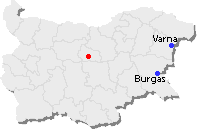
The monastery of “St Archangel – Michael” was constructed during the period of the II-nd Bulgarian Kingdom (the beginning of XII C.) in the land called “tsarkvisteto” (the church place) , very close to the Summer Residence of the Bulgarian kings from the Asen Dynasty. During the Turkish domination period the Monastery was twice destroyed and robbed (XIV and XVII C) then quickly reconstructed to become a stronghold of the Bulgarian spirit till today.
The present-day monastery was renovated in 1845 when the small, built-in-ground church of “St Archangel – Michael” was built. The church is made of stone and has no dome but an eight-walled bell tower in its construction.
The other church of “The Assumption of Holy Mother” date back to 1861 while its iconostasis was created in 1876 by N.Yonkov.
The Monastery had been a refuge for many leaders of the National Revival and revolutionaries during the struggles for the liberation of Bulgaria.
In 1876 during the April Rising, after nine-day struggle of the Bulgarian rebels and the Turkish Army the Monastery was burned down and completely destroyed.
In 1880 it was rebuilt and in 1897 a bone vault “Monument of the dead soldiers” was erected on the place where the church of “The Assumption of Holy Mother “was in 1861.
The monastery is placed in the picturesque defile of Drushlyavitsa River where limestone cliffs surround the defile like unreachable fortress walls.
In the present days the Dryanovo monastery is active and monks can be seen there.
It is one of the most honored holy places of Bulgaria, a national and historic monument and much visited tourist place.
The Monastery offers accommodation and food. It is situated 5 km southeast of the town of Dryanovo and 15 km of the town of Gabrovo.
Up above the monastery building, among the steep vertical cliffs is the Natural site – The Bacho Kiro Cave. According to historians the cave was inhabited since the Stone Age.















